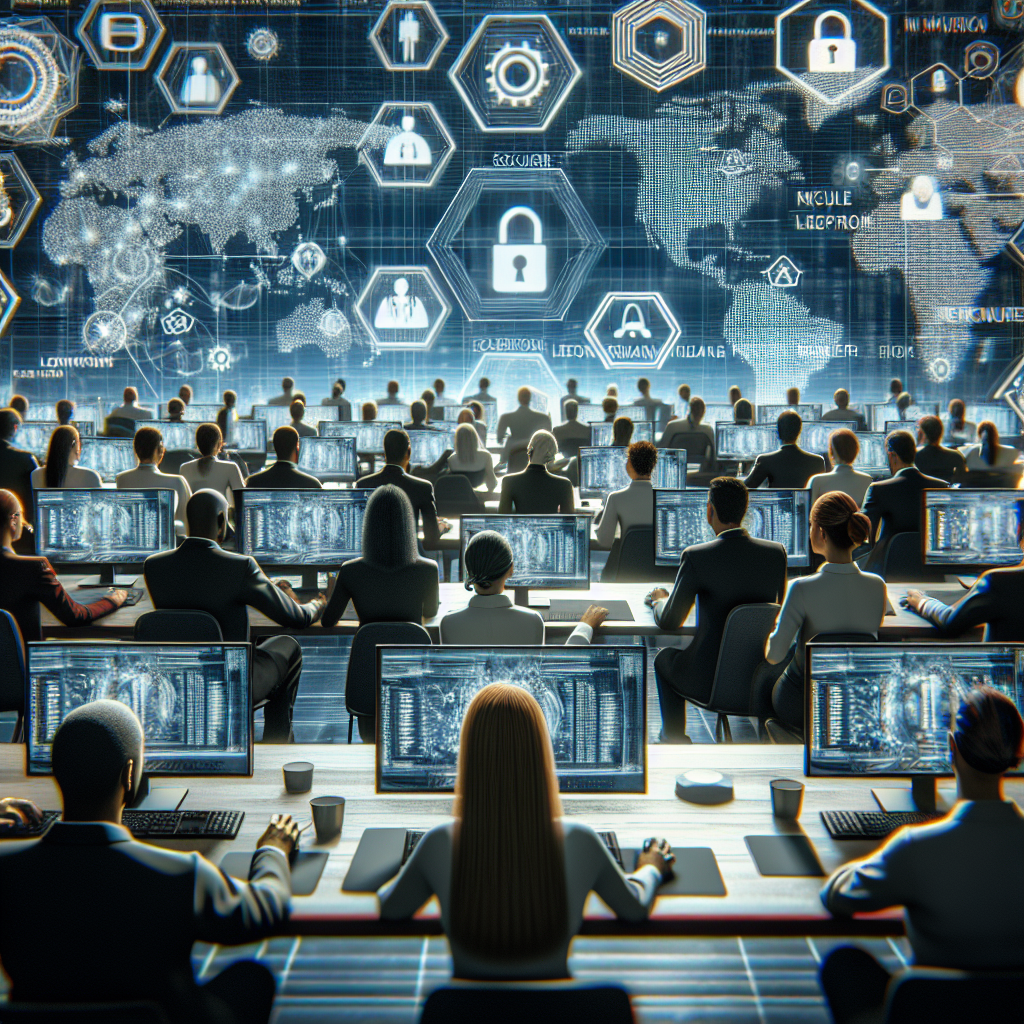Your cart is currently empty!
Tag: employees

The Human Element of Disaster Recovery: How to Safeguard Your Employees and Customers
Disaster recovery planning is an essential aspect of any business’s operations. It ensures that in the event of a disaster, whether natural or man-made, the organization can continue to operate and serve its customers. However, many businesses overlook the human element of disaster recovery – the employees and customers who are directly impacted by the disaster. Safeguarding their well-being should be a top priority for any organization.When a disaster strikes, the first concern should always be the safety and well-being of employees. Ensuring that they are safe and accounted for should be the first step in any disaster recovery plan. This means having clear evacuation procedures in place, as well as designated meeting points for employees to gather in the event of an emergency. It also means having a system in place to communicate with employees and keep them informed of the situation.
In addition to physical safety, businesses should also consider the emotional well-being of their employees. Disasters can be traumatic events, and employees may need support and counseling to help them cope with the aftermath. Providing access to mental health resources and support services can go a long way in helping employees recover from a disaster.
Customers are another important consideration in disaster recovery planning. In the event of a disaster, customers may be left without access to the goods or services they rely on. Businesses should have a plan in place to communicate with customers and keep them informed of any disruptions to service. This may involve setting up a hotline or dedicated customer service team to field inquiries and provide updates.
Businesses should also consider how they can help their customers recover from a disaster. This may involve offering discounts or special promotions to help customers get back on their feet, or providing resources and information to help them navigate the recovery process. By demonstrating a commitment to their customers’ well-being, businesses can build loyalty and trust even in the face of a disaster.
In conclusion, safeguarding the human element of disaster recovery is essential for any business. By prioritizing the safety and well-being of employees and customers, businesses can not only minimize the impact of a disaster but also build resilience and strengthen relationships with those who matter most. Disaster recovery planning should always consider the human element, ensuring that everyone impacted by a disaster is supported and cared for during a challenging time.
Remote Monitoring in the Age of COVID-19: Keeping Employees Safe and Productive
The COVID-19 pandemic has brought about many changes in the way we work, with remote monitoring becoming a crucial tool for keeping employees safe and productive. As businesses navigate the challenges of operating during a global health crisis, the need for remote monitoring solutions has become more apparent than ever before.Remote monitoring allows employers to keep track of their employees’ activities, regardless of where they are working from. This can be especially important in situations where employees are working from home, as it provides a way to ensure that they are staying on task and meeting deadlines. In addition, remote monitoring can help employers identify potential issues or concerns that may arise, such as cybersecurity threats or performance issues.
One of the key benefits of remote monitoring is the ability to keep employees safe during a time when social distancing and other safety measures are of utmost importance. By monitoring employee activities remotely, employers can minimize the need for in-person interactions and reduce the risk of exposure to the virus. This can help to protect employees and their families, as well as prevent the spread of COVID-19 within the workplace.
Remote monitoring can also help to improve employee productivity during these challenging times. By providing employers with real-time insights into employee activities, remote monitoring can help to identify areas where employees may be struggling and provide support or resources to help them succeed. This can be especially important in a remote work environment, where employees may be facing new challenges and distractions that can impact their performance.
In addition, remote monitoring can help to ensure that employees are complying with company policies and procedures, even when working remotely. This can help to maintain a sense of accountability and professionalism among employees, even when they are working from home. By monitoring employee activities, employers can also ensure that sensitive information is being handled securely and that company data is protected from potential threats.
Overall, remote monitoring is an essential tool for businesses looking to navigate the challenges of operating during the COVID-19 pandemic. By keeping employees safe and productive, remote monitoring can help businesses to weather the storm and emerge stronger on the other side. As we continue to adapt to the new normal of remote work, remote monitoring will play a crucial role in ensuring the safety and success of employees and businesses alike.

Building a Strong Business Continuity Culture: Tips for Engaging Employees and Stakeholders
In today’s fast-paced business world, having a strong business continuity plan in place is essential for ensuring the long-term success and sustainability of a company. However, simply having a plan in place is not enough – it is crucial to also build a strong business continuity culture within the organization. This involves engaging employees and stakeholders in the process and fostering a mindset of preparedness and resilience.Here are some tips for building a strong business continuity culture and engaging employees and stakeholders in the process:
1. Communicate the importance of business continuity: It is important to educate employees and stakeholders about the importance of business continuity and how it contributes to the overall success and sustainability of the organization. Make sure to communicate the potential risks and consequences of not having a solid plan in place, and emphasize the need for everyone to play a role in ensuring the organization’s resilience.
2. Involve employees in the planning process: Engage employees in the development of the business continuity plan by seeking their input and feedback. This not only helps to ensure that the plan is comprehensive and effective, but also fosters a sense of ownership and responsibility among employees. Encourage employees to participate in training and drills to test the plan and familiarize themselves with their roles and responsibilities.
3. Provide training and resources: Offer training sessions and resources to help employees and stakeholders understand their roles and responsibilities in the event of a disruption. This can include training on emergency procedures, communication protocols, and how to access and use key resources during a crisis. Make sure to regularly update and refresh training materials to keep everyone informed and prepared.
4. Recognize and reward preparedness: Recognize and reward employees and stakeholders who demonstrate a commitment to business continuity and preparedness. This can help to reinforce the importance of maintaining a strong business continuity culture and encourage others to follow suit. Consider implementing a recognition program or incentives for employees who go above and beyond in ensuring the organization’s resilience.
5. Foster a culture of transparency and collaboration: Encourage open communication and collaboration among employees and stakeholders when it comes to business continuity planning. Make sure that everyone is aware of the plan and their roles in implementing it, and encourage feedback and suggestions for improvement. Create a supportive environment where employees feel comfortable raising concerns and working together to address any issues that may arise.
By following these tips and engaging employees and stakeholders in the business continuity planning process, organizations can build a strong business continuity culture that ensures preparedness and resilience in the face of potential disruptions. Investing in building a strong business continuity culture is an investment in the long-term success and sustainability of the organization.

Cybersecurity Awareness: Educating Yourself and Your Employees
In today’s digital age, cybersecurity has become a critical concern for businesses of all sizes. With cyber threats on the rise, it is more important than ever for individuals and organizations to educate themselves on best practices for protecting sensitive information and data.One of the first steps in enhancing cybersecurity awareness is to educate yourself and your employees on the importance of cybersecurity. This includes understanding the types of cyber threats that exist, such as phishing scams, malware, ransomware, and social engineering attacks. By being aware of these threats, individuals can better protect themselves and their organization from falling victim to cyber attacks.
It is also essential to stay up-to-date on the latest cybersecurity trends and developments. Cyber threats are constantly evolving, so it is important to regularly educate yourself and your employees on new tactics and techniques that cyber criminals may use to breach your systems.
Another crucial aspect of cybersecurity awareness is implementing strong security measures within your organization. This includes using complex passwords, enabling multi-factor authentication, regularly updating software and systems, and conducting regular security audits to identify and address vulnerabilities.
Training your employees on cybersecurity best practices is also key to preventing cyber attacks. Employees are often the weakest link in an organization’s security posture, as they may inadvertently click on malicious links or download infected files. By providing cybersecurity training and education, employees can become more vigilant and proactive in protecting sensitive information.
Additionally, it is important to create a culture of cybersecurity within your organization. This includes promoting a mindset of security awareness and accountability among employees, as well as encouraging open communication about potential security threats and concerns.
Overall, cybersecurity awareness is essential for protecting your organization from cyber attacks. By educating yourself and your employees on the importance of cybersecurity, staying informed on the latest trends, implementing strong security measures, and fostering a culture of security within your organization, you can significantly reduce the risk of falling victim to cyber threats. Remember, cybersecurity is everyone’s responsibility, so take the necessary steps to protect yourself and your organization today.

Cybersecurity in the Workplace: Best Practices for Employees and Employers
Cybersecurity in the Workplace: Best Practices for Employees and EmployersIn today’s digital age, cybersecurity has become a critical issue for businesses of all sizes. With the increasing number of cyber threats and data breaches, it is more important than ever for both employees and employers to take proactive steps to protect sensitive information and prevent unauthorized access to company data.
Employees play a crucial role in maintaining cybersecurity in the workplace. By following best practices and taking the necessary precautions, they can help prevent cyber attacks and keep company data safe. Here are some key tips for employees to follow:
1. Use strong passwords: Employees should use complex passwords that are difficult to guess and change them regularly. Passwords should be a combination of letters, numbers, and special characters to ensure maximum security.
2. Be cautious of phishing emails: Phishing emails are a common tactic used by cyber criminals to trick employees into revealing sensitive information. Employees should be wary of emails from unknown senders and avoid clicking on suspicious links or attachments.
3. Keep software up to date: Employees should regularly update their software and applications to patch any security vulnerabilities. Outdated software can be easily exploited by cyber criminals to gain access to sensitive information.
4. Use secure networks: Employees should only connect to secure Wi-Fi networks, especially when accessing company data or sensitive information. Public Wi-Fi networks are often unsecure and can leave devices vulnerable to cyber attacks.
Employers also play a crucial role in maintaining cybersecurity in the workplace. By implementing robust security measures and providing employees with the necessary training and resources, employers can create a secure work environment. Here are some best practices for employers to follow:
1. Implement a cybersecurity policy: Employers should establish a comprehensive cybersecurity policy that outlines the company’s security protocols and procedures. This policy should be regularly reviewed and updated to ensure it remains effective against evolving cyber threats.
2. Provide cybersecurity training: Employers should provide employees with regular training on cybersecurity best practices, including how to identify phishing emails, use secure passwords, and protect sensitive information. Training sessions should be mandatory for all employees to ensure everyone is aware of the risks and how to mitigate them.
3. Use encryption and access controls: Employers should implement encryption technology to protect sensitive data and restrict access to authorized personnel only. Access controls should be put in place to limit who can access certain information and prevent unauthorized users from gaining entry.
4. Monitor and audit systems: Employers should regularly monitor their systems for any suspicious activity and conduct regular audits to identify potential vulnerabilities. By staying vigilant and proactive, employers can detect and address security threats before they escalate.
In conclusion, cybersecurity is a shared responsibility between employees and employers. By following best practices and implementing robust security measures, businesses can protect sensitive information and prevent data breaches. By working together, employees and employers can create a secure work environment that safeguards company data and minimizes the risk of cyber attacks.

Why Cybersecurity Training is Crucial for Employees in Today’s Digital Age
In today’s digital age, cybersecurity threats are becoming more prevalent and sophisticated than ever before. As technology continues to advance, so do the tactics of cybercriminals who are constantly looking for ways to exploit vulnerabilities in systems and networks. This is why cybersecurity training for employees is crucial in order to protect sensitive information and prevent cyber attacks.One of the main reasons why cybersecurity training is essential for employees is because they are often the first line of defense against cyber threats. Many cyber attacks are initiated through phishing emails, malware infections, or social engineering tactics that target unsuspecting employees. By providing employees with the knowledge and skills to recognize and respond to these threats, organizations can significantly reduce the risk of a successful cyber attack.
Furthermore, cybersecurity training helps employees understand the importance of following best practices for data security, such as creating strong passwords, encrypting sensitive information, and regularly updating software and systems. This can help prevent data breaches and unauthorized access to confidential information, which can have serious consequences for both individuals and organizations.
In addition, cybersecurity training can also help employees understand their role in maintaining a culture of security within the organization. By emphasizing the importance of cybersecurity and promoting a culture of vigilance and responsibility, employees can become more proactive in identifying and reporting potential security threats, ultimately helping to strengthen the overall security posture of the organization.
Overall, cybersecurity training for employees is crucial in today’s digital age in order to protect sensitive information, prevent cyber attacks, and maintain a culture of security within organizations. By investing in cybersecurity training, organizations can empower their employees to be proactive in defending against cyber threats and ultimately reduce the risk of a successful cyber attack.

Remote Monitoring for Remote Work: Keeping Employees Connected and Productive
Remote work has become increasingly popular in recent years, with many companies offering employees the flexibility to work from home. While this setup offers numerous benefits, such as improved work-life balance and reduced commute times, it also presents some challenges, particularly in terms of keeping employees connected and productive.One solution to this issue is remote monitoring, which allows employers to keep track of their employees’ activities and productivity levels while they work from home. Remote monitoring tools can provide valuable insights into how employees are spending their time, whether they are meeting deadlines, and if they are staying on task.
One of the key benefits of remote monitoring is that it helps to maintain a sense of accountability among employees. When employees know that their work is being monitored, they are more likely to stay focused and productive. This can be especially important for remote workers who may lack the structure and supervision of a traditional office environment.
Remote monitoring can also help employers identify any potential issues or bottlenecks in the workflow. By tracking employees’ activities and progress on tasks, managers can quickly address any issues that may be hindering productivity and make adjustments as needed.
Additionally, remote monitoring can be a valuable tool for ensuring that employees are complying with company policies and procedures. For example, if employees are required to log their hours or adhere to specific work schedules, remote monitoring can help ensure that these guidelines are being followed.
Of course, it is important to strike a balance when it comes to remote monitoring. While it can be a valuable tool for keeping employees connected and productive, it is also important to respect employees’ privacy and autonomy. Employers should be transparent about the use of remote monitoring tools and ensure that they are being used in a fair and ethical manner.
In conclusion, remote monitoring can be a valuable tool for keeping employees connected and productive while working from home. By providing insights into employees’ activities and productivity levels, remote monitoring can help maintain accountability, identify potential issues, and ensure compliance with company policies. Ultimately, remote monitoring can help employees and employers alike navigate the challenges of remote work and achieve success in a virtual work environment.
Federal Employees Pronouns: Trump asks federal employees to remove pronouns from email signatures. Here’s what it means
Employees at multiple federal agencies have been asked to remove pronouns from their email signatures by this afternoon, ABC News reported citing internal memos. The memo is based on two executive orders signed by President Donald Trump on his first day in office ending DEI programs in the government. “Pronouns and any other information not permitted in the policy must be removed from CDC/ATSDR employee signatures by 5.p.m. ET on Friday,” according to one such message sent Friday morning from Jason Bonander, the CDC’s Chief Information Officer. “Staff are being asked to alter signature blocks by 5.p.m. ET today (Friday, January 31, 2025) to follow the revised policy.”
It is not yet known which agencies received the memo as the report said that the transport department received a similar directive on Thursday when they were managing the emergency of the DC plane crash near Ronald Reagan Washington National Airport.
Energy department employees also received a similar notice Thursday and they were told that this was to meet requirements in Trumo’s executive order calling for the removal of DEI “language in Federal discourse, communications and publications”.
The memo also asked each agency to effectively institute trans bathroom bans.
Memo in line with Trump’s executive order
Donald Trump signed two executive orders calling for an and to what his administration called “radical and wasteful DEI programs” and seeking to restore the “biological truth to the federal government”. In one of those executive orders, each agency, or department of the government has been asked to terminate “to the maximum extent allowed by law” all DEI (diversity, equity, inclusivity) offices and positions.
The Trump administration has cracked the whip on federal workers and asked them to work from the office or to take a deferred resignation program in which they will get their pay and other benefits for eight months if they accept to resign by February 6.
Recently, President Trump issued a directive to federal employees, requesting that they remove their preferred pronouns from their email signatures. This decision has sparked controversy and raised questions about the importance of inclusivity in the workplace.For many individuals, including their preferred pronouns in their email signature is a way to affirm their gender identity and ensure that others respect and acknowledge it. By removing this option, some argue that the Trump administration is disregarding the importance of diversity and inclusion in the workplace.
On the other hand, supporters of the directive argue that including pronouns in email signatures is unnecessary and could be seen as promoting a political agenda. They believe that employees should focus on their work and not on their gender identity.
Overall, the debate surrounding this issue highlights the ongoing struggles for recognition and acceptance of diverse identities in the workplace. It remains to be seen how federal employees will respond to this directive and what impact it will have on the overall culture of inclusivity within government agencies.
Tags:
Federal Employees, Pronouns, Trump, Email Signatures, Gender Identity, Workplace Policies, Diversity and Inclusion, Government Employees, Political News, Pronoun Usage, Communication Guidelines
#Federal #Employees #Pronouns #Trump #asks #federal #employees #remove #pronouns #email #signatures #Heres #meansFederal employees told to remove pronouns from email signatures by end of day
Employees at multiple federal agencies were ordered to remove pronouns from their email signatures by Friday afternoon, according to internal memos obtained by ABC News that cited two executive orders signed by President Donald Trump on his first day in office seeking to curb diversity and equity programs in the federal government.
“Pronouns and any other information not permitted in the policy must be removed from CDC/ATSDR employee signatures by 5.p.m. ET on Friday,” according to one such message sent Friday morning from Jason Bonander, the CDC’s Chief Information Officer. “Staff are being asked to alter signature blocks by 5.p.m. ET today (Friday, January 31, 2025) to follow the revised policy.”
Federal employees with the Department of Transportation received a similar directive on Thursday, the same day the department was managing the fallout from the D.C. plane crash near Ronald Reagan Washington National Airport.
Employees were instructed to remove pronouns from everything from government grant applications to email signatures across the department, sources told ABC News.
Employees at the Department of Energy who received a similar notice Thursday were told this was to meet requirements in Trump’s executive order calling for the removal of DEI “language in Federal discourse, communications and publications.”
It was not immediately clear whether employees in other federal agencies received similar messages. Spokespeople for the Transportation Department, Energy Department, HHS and CDC did not immediately respond to a request for comment from ABC News.
The mandate to remove pronouns from email signatures is the latest result of the Trump administration’s push to do away with diversity and equity efforts in the federal government.

President Donald Trump signs executive orders in the Oval Office at the White House in Washington, Jan. 30, 2025.
Elizabeth Frantz/Reuters
On his first day in office, Trump signed a pair of executive orders calling for an end to what his administration called “radical and wasteful DEI programs” and seeking to restore “biological truth to the federal government.” Both orders were referenced in the Friday message to agencies.
The memos included instructions for how to edit email signatures.
At least one career civil servant met the order with irritation.
“In my decade-plus years at CDC I’ve never been told what I can and can’t put in my email signature,” said one recipient, who asked not to be identified out of fear of retribution.
A memo issued Wednesday by the Office of Personnel Management also directed agencies to “Review agency email systems such as Outlook and turn off features that prompt users for their pronouns.”
ABC News’ Cheyenne Haslett contributed to this report.
Attention all federal employees:In a recent memo from the Department of Administration, all federal employees are being instructed to remove pronouns from their email signatures by the end of the day. This directive comes as part of a new initiative to promote gender-neutral language and inclusivity in all communications.
While some may find this change to be a minor adjustment, it is an important step towards creating a more inclusive and respectful work environment for all employees. By removing pronouns from email signatures, we are sending a message that we value and respect everyone’s identity and preferences.
We understand that this change may take some time to get used to, but we ask for your cooperation in implementing this policy. If you have any questions or concerns, please reach out to your supervisor or the Department of Administration for clarification.
Thank you for your attention to this matter and for your commitment to promoting diversity and inclusivity in the workplace. Let’s work together to create a more welcoming and respectful environment for all federal employees.
Tags:
- Federal employees
- Pronouns
- Email signatures
- Workplace communication
- Gender-neutral language
- Office etiquette
- Federal government
- Professionalism
- Diversity and inclusion
- Communication guidelines
#Federal #employees #told #remove #pronouns #email #signatures #day
Costco Raises Pay To Over $30 An Hour For Non-Union Employees, Leaving 18,000 Union Members Waiting
Topline
Costco announced that all employees at its non-union stores will get a pay raise, just a day before employees at its 50 unionized locations are set to go on strike, according to Bloomberg.
Costco employee greeting customer and checking membership status, Costco, Florida. (Photo by: … [+]
Key Facts
Hourly pay for non-union members at the top of Costco’s pay scale will get a $1 per hour raise to $30.20 per hour with a $1 per hour raise coming each of the next two years afterwards.
More than half of Costco’s employees are at the top of its pay scale, owing to extremely low turnover.
Non-union employees at the lower-end of the pay scale will receive a $0.50 per hour increase, raising starting pay to $20 per hour.
Additional benefits will also be granted, including an extra week of vacation after 30 years and vacation for new workers in their first year.
The extra pay and benefits will affect over 200,000 of Costco’s non-union employees as its 18,000 union members wait for a new contract.
Background
Costco has long been the retail employer of choice because of its industry-leading wages and benefits. This move will raise Costco a couple of notches higher and attract those seeking a retail career, rather than just using a retail job as a stepping stone.
Big Number
Overall, the retail trade is the nation’s number-one private employer, supporting some 16 million jobs directly at the end of last year. Median hourly pay for a retail sales person is just over $16 per hour, according to the Bureau of Labor Statistics.
Crucial Quote
“With these changes, we believe our hourly wages and benefits will continue to far outpace others in the retail industry,” CEO Ron Vachris wrote in a company memo announcing the changes.
Tangent
The company’s roughly 18,000 International Brotherhood of Teamsters union members working in some 50 of its 624 U.S. Costco stores will not be entitled to the same pay raise and added benefits. That will have to wait for a new contract with the current one set to expire at midnight tonight. Earlier this month the Teamsters voted to strike if an agreement isn’t reached. A Costco Teamsters’ spokesperson claimed that it was due to the group’s pressure that the pay increases were granted.
What We Don’t Know
We don’t know when the pay raises will take effect for non-union Costco employees. And we have no word yet about where contract negotiations stand. However, labor relations attorney Jane Jacobs shared with me that the Costco announcement could signal the company will meet the union demands. “Strikes are an extremely expensive proposition for everyone involved. There are no winners in a strike, including the employees who lose wages.”
Further Reading
Costco Raises Pay to Over $30 an Hour for Most Store Workers (Bloomberg, 1/31/2025)
Costco to Raise Pay Hourly Pay for Most U.S. Workers to over $30 per Hour (Reuters, 1/31/2025)
Costco’s recent announcement to raise pay for non-union employees to over $30 an hour has left 18,000 union members waiting for their own pay increase. The move has sparked debate among Costco employees and union representatives, with many questioning why non-union workers are receiving a higher wage.Costco, known for its competitive wages and benefits, has faced pressure from both employees and labor unions to increase pay for all workers. The company’s decision to raise pay for non-union employees comes at a time when many companies are facing labor shortages and increasing competition for workers.
Union members at Costco are now calling for fair treatment and equal pay for all employees, regardless of their union status. They argue that all workers contribute to the company’s success and should be compensated fairly for their work.
As Costco continues to navigate the challenges of the current labor market, it remains to be seen how the company will address the concerns of its union members. In the meantime, the debate over fair pay and compensation for all employees is likely to continue.
Tags:
- Costco pay increase
- Costco employee wages
- Costco union members
- Costco hourly pay
- Costco non-union employees
- Costco wage hike
- Costco labor union
- Costco worker compensation
- Costco employee benefits
- Costco wage increase
#Costco #Raises #Pay #Hour #NonUnion #Employees #Leaving #Union #Members #Waiting

